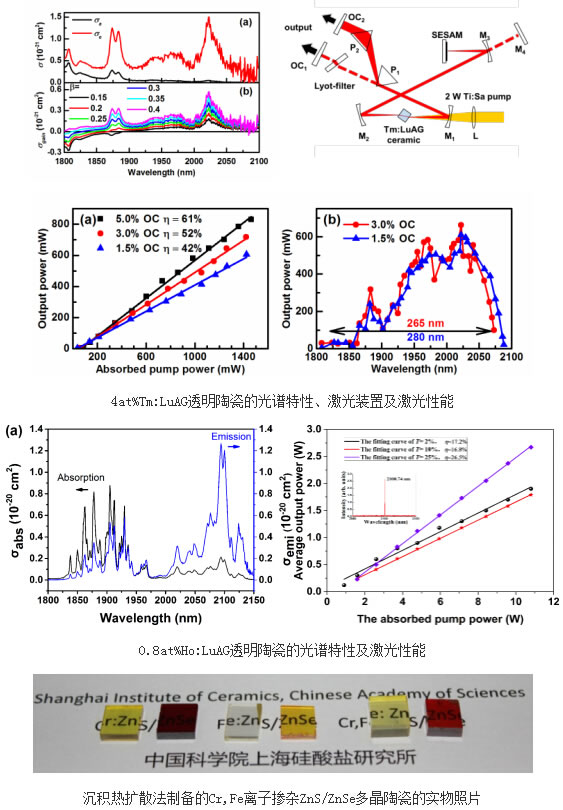
The mid-infrared (2-5μm) band laser is at the same time located in the atmospheric window region and the molecular fingerprint region, and has application value in the fields of atmospheric remote sensing, spectroscopy, medical diagnosis, optical communication and direct infrared countermeasures. Among the various means for achieving mid-infrared laser output, solid materials based on rare earth ions (Tm3+ and Ho3+) doped ytterbium/yttrium aluminum garnet and transition metal ion doped II-VI compound (TM2+:II-VI) gain material The laser has an important role. Recently, the transparent and functional ceramics research team led by Li Jiang, researcher of the Shanghai Institute of Ceramics, Chinese Academy of Sciences, prepared a new type of high quality 4at%Tm:LuAG ceramic transparent and cooperated with the Institute of Nonlinear Optics, Maxwell, Germany. For the first time in the world, a Tm:LuAG ceramic has a 2022 nm continuous laser output of 0.83 W (pump source: 787 nm Ti:sapphire laser), a slope efficiency of up to 61% (output coupling mirror transmittance TOC = 5%), and a tunable laser wavelength range It is 1808 to 2073 nm. In cooperation with Harbin Institute of Technology, the 0.8at% Ho:LuAG ceramic developed by the research team achieved a continuous laser output of 2.67W at 2100.7nm (pump source: 1907.5nm Tm: YLF laser) and a slope efficiency of 26.5% (highest in international reports). Beam quality M2 = 1.1.
The rare-earth ions (Tm3+ and Ho3+) doped yttrium/yttrium aluminum garnet transparent ceramics have good physicochemical properties and spectral characteristics and are excellent 2μm solid-state laser gain media. The research team produced high-quality Tm:YAG and Ho:YAG transparent ceramics and cooperated with the Institute of Nonlinear Optics in Maxwell, Germany to achieve a high-performance continuous laser output. Using a continuous Ti:sapphire laser as the pump source, the Tm:YAG ceramic achieves a 2 μm-band SESAM mode-locked laser output with a pulse width of 3 ps and an average output power of approximately 150 mW at a repetition rate of 89 MHz. Using a 1.9μm Tm fiber laser with the pumped Ho:YAG ceramic, 2090.4nm and 2094.0nm continuous laser outputs were achieved, with slope efficiency as high as 88% and 83%. Using a semiconductor saturable absorber mirror (SESAM), a stable mode-locking operation of the Ho:YAG ceramic in the 2059 nm to 2121 nm range was achieved. The research team's breakthrough in the direction of the new Tm/Ho:LuAG laser ceramics has further broadened the range of choice for high-performance mid-infrared laser materials.
A solid-state laser using a transition metal ion-doped II-VI compound polycrystalline ceramic as a gain medium has the advantages of ultra-wideband tuning, high quantum efficiency, and the potential for high-power, high-energy mid-infrared laser output. At the same time, since Cr2+/Fe2+:II-VI and other materials have no excited-state absorption, their theoretical quality factor (FOM) is infinite, and they can also be used as saturable absorbers of mid-infrared passive Q-switched lasers. The research team prepared a high-quality Cr:ZnS/ZnSe transparent ceramic material by thermal diffusion method and cooperated with professor Yao Baoquan of Harbin Institute of Technology. The Cr:ZnSe ceramic gain medium achieved a maximum power of 418mW at room temperature and a slope efficiency of 12.8. % continuous laser output. Using Cr:ZnS as a passively Q-switched saturable absorber, a narrow pulse width, high power PQS laser output of a Ho:YAP, Ho:LuAG laser was achieved.
Compared with the deposition thermal diffusion method, the ceramic preparation method can avoid the co-melting of the dopant in the TM:ZnS/ZnSe and the matrix at a high temperature, realize the uniform distribution of the doped ions, and facilitate the structural design for better thermal management. In addition, ceramics have more excellent mechanical properties and thermal shock resistance, simple preparation process, low cost, and scale production. The research team used wet chemical method to synthesize Fe2+:ZnS nano-powder, and then prepared a high optical quality Fe2+:ZnS transparent ceramic by hot-pressing sintering combined with hot isostatic pressing post-processing. The transmittance of the sample at 2.0 μm The transmission rate of ~45% at 5.0μm is ~70%. This is the hot-pressed Fe2+:ZnS transparent ceramic with the best optical quality reported so far.
The research work was funded by the National Natural Science Foundation of China and the Frontier Science Research Program of the Chinese Academy of Sciences.
Camouflage Pattern Steel Coil is a pattern design Prepainted Steel Coil, it's widely used as material for army station construction.
The base metal could be galvanized steel, galvalume steel, stainless steel. Paint coating could be PE, HDP, FEVE, PVDF, we cooperate with famous brand of PPG, Beckers, Akzo Nobel, etc. We offer 20 years warranty for PVDF coating.
Camouflage Pattern Steel Coil
Camouflage Pattern Steel Coil,Camouflage Ppgi Steel Wall,Camouflage Wall Panel,Camouflage Steel In Coil
Shandong Wofeng New Material Co., Ltd. , https://www.wofengcoil.com